When I first started to live on Thompson Island I often said that I "didn't emotionally understand the ocean." I could explain how the moon's gravitational pull makes the water move around the globe, but when I would stand on the shore I would think "how do I know the ocean is going to keep going down or coming up?" It may sound silly for those with tons of ocean experience, but it felt like someone who had never seen the sun rise and set.
To get to know the ocean a little better, I try to spend a part of each day just listening to it. My view is often like the picture below with such a great sight of the City on the Hill (well, technically three but who's counting). Besides the tides, one of the biggest differences of living in the harbor vs Diablo Lake in Washington is the smell of salt.
But what really is salinity? How does it work?
View of Boston from our western shore. Photo courtesy of Boston Harbor Beacon.
Salinity On Earth
“Salinity is just salt in water Ben...duh...”
I mean, yes! But it is much more interesting!
If you look at the most common of salts, Sodium Chlolride (NaCl, aka table salt) makes up the majority of salt in the ocean. Since the forming of the oceans billions of years ago, water has been eroding rock and carrying minerals. In water NaCl dissolves because they have a weak bond to one another. H2O has a more positively charged side, and one that is more negatively charged. When the NaCl dissolve the sodium tend to hang out with the negative side (since it is positvely charged) and chlorine hangs with the positive. Just one molecule of NaCl would be undetectable to the human tongue, but when we are dealing with salt water we are dealing in the thousands!
Parts per thousand means that for every thousand molecules in a certain area, so many of them are what you are measuring. Looking at the chart below you can see how even just a little bit will completely change the chemistry of water.
Salinity chart. Made by Peter Summerlin. Retrieved from Wikipedia.
Our normal drinking water has very little to no salt in it. But going up to even 2ppt limits what plants can use it. But on the island we are not just dealing with the harbor as our only water ecosystem...
Students exploring the western salt marsh. Photo found at the Thompson Island Wordpress.
Case Study: Eastern Salt Marsh
This spring I personally brought dozens of students out to our marshes to explore. The island is fortunate enough to have two salt marshes, a larger to the west and the smaller to the east. When our students measured the salinity in three locations on the island, these were the results they got on average:
- Freshwater pond: 0ppt
- Ocean: 22ppt
- Eastern Salt Marsh: 28ppt
How on earth does the marsh have a higher salinity than the ocean?! The same process that made the ocean salty is making our marshes saltier. When water carries salt ions down to the ocean and then evaporate, the concentration of salt increases not only because more salt is added but because water is being taken out of the system. In our global systems this salt has more room to 'equal out' giving a more uniform salinity. Even though it can be different in different parts of the world, this is why the water is still salty in the middle of the Pacific where there is very little land to erode.
But our salt marsh doesn't have as much room for the salt to disperse. Each day the tide comes in and goes out twice. Each time it brings salt (along with tons of other minerals). When it goes out it may take some salt with it, but not all of it. Over the years this has caused our marsh to be naturally saltier than the surrounding harbor.
Why is this a good thing? We have tons of organisms that depend on the high salinity to survive. From grasses to crabs, birds to snails, they need this unique habitat to fully thrive. So the next time you see any kind of wetland, take a deep breathe to determine if it is freshwater or salty!




